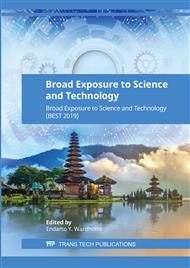p.114
p.122
p.128
p.137
p.144
p.153
p.162
p.169
p.175
Hydrogen Sulfide Separation from Biogas Using Laterite Soil Adsorbent
Abstract:
Biogas production contributes as an alternative renewable energy but its emissions contain sulphuric components which needs to be separated because it can cause damage to the environment. The method used in separation is adsorption with laterite soil because the price is cheap, easy to obtain, and can occur at room temperature. The purpose of this study is to determine the conditions of the adsorbent in the adsorption column which can provide a high adsorption capacity. The separation process is carried out by flowing biogas with a flow rate of 1.5 liters/minute to the adsorption column containing laterite soil. Reducing the particle size of the adsorbent from 6 mesh to 21 mesh will increase the adsorption capacity to 2.13 times, ie from 7.3 to 14.2 mg H2S/g adsorbent. The addition of bed height from 7 cm to 12 cm will increase the adsorption capacity from 6.7 to 7.9 mg H2S/g adsorbent at 6 mesh particle size. The addition of bed height from 7 cm to 12 cm will increase the adsorption capacity from 13.5 to 15.0 mg H2S/g adsorbent at 21 mesh particle size. The laterite soil adsorbent with a particle size of 21 mesh has the highest adsorption capacity of 15.0 mg H2S/g adsorbent.
Info:
Periodical:
Pages:
144-150
Citation:
Online since:
April 2020
Keywords:
Price:
Сopyright:
© 2020 Trans Tech Publications Ltd. All Rights Reserved
Share:
Citation:



